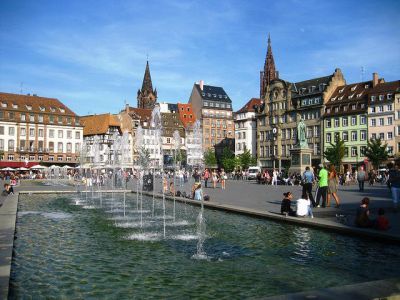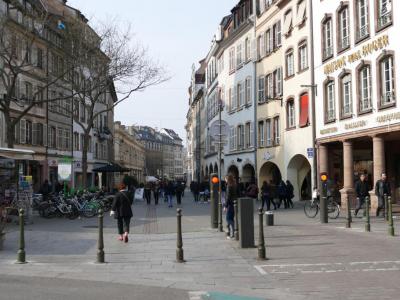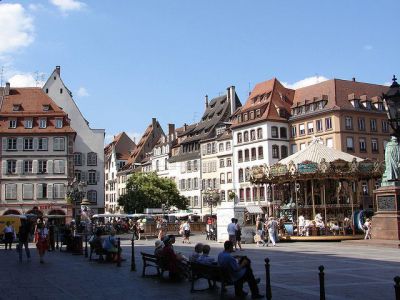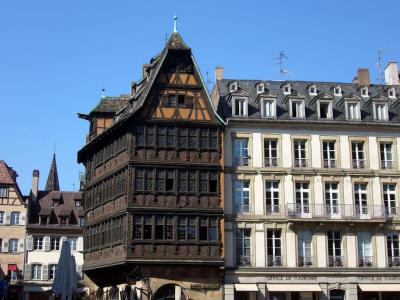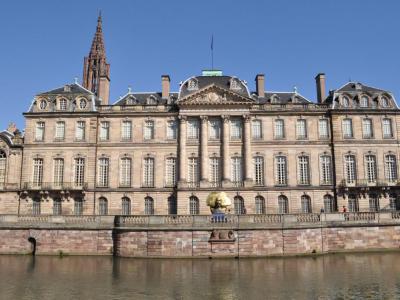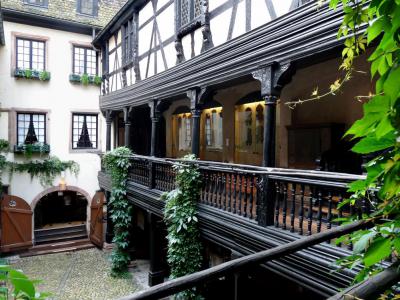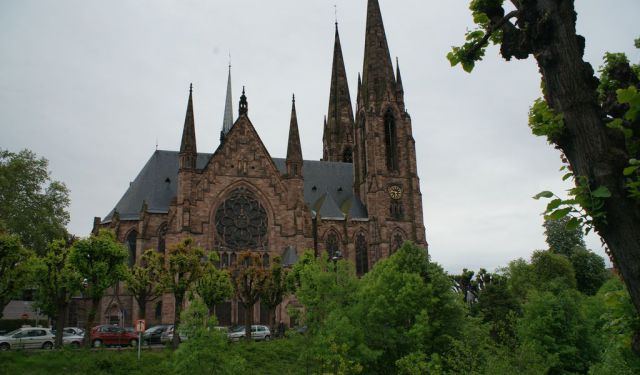
Strasbourg Downtown Walking Tour (Self Guided), Strasbourg
Strasbourg – the daughter of the Rhine River – is rich in history, architecture and gastronomy. This is particularly true of the downtown part of the city, the Grande Île or Große Insel in German, which means "Large Island" – a designated UNESCO World Heritage Site since 1988.
At the centre of the island lies Place Kléber, the city's central square and main meeting place since the 14th century. Further south is Strasbourg Cathedral, an ornate example of 15th-century Gothic architecture renowned for its astronomical clock and tower dominating the skyline, described by Victor Hugo as a "gigantic and delicate marvel" and by Goethe as a "sublimely towering, wide-spreading tree of God".
All the other key local attractions are also nearby, within a walking distance from each other. Among them:
Aubette Building – originally a monastic complex from the 13th century; an important historic landmark, nicknamed the Sistine Chapel of Abstract Art.
Rue des Grandes Arcades (Grand Arcades Street) – one of the city's central shopping districts, busy day and night.
Place Gutenberg – a definite “must-see”, not far from Strasbourg Cathedral.
Rue Mercière (Merchants Street) – probably the most popular medieval street in the city, with a breathtaking view of the Cathedral.
Place de la Cathédrale (Cathedral Square) – another great place to admire the magnificent Strasbourg Cathedral's Gothic exterior.
Maison Kammerzell (Kammerzell House) – a well-preserved medieval building, with essential Late Gothic charm and excellent restaurant inside.
To discover these and other prominent sights of Downtown Strasbourg, take this self-guided walking tour.
At the centre of the island lies Place Kléber, the city's central square and main meeting place since the 14th century. Further south is Strasbourg Cathedral, an ornate example of 15th-century Gothic architecture renowned for its astronomical clock and tower dominating the skyline, described by Victor Hugo as a "gigantic and delicate marvel" and by Goethe as a "sublimely towering, wide-spreading tree of God".
All the other key local attractions are also nearby, within a walking distance from each other. Among them:
Aubette Building – originally a monastic complex from the 13th century; an important historic landmark, nicknamed the Sistine Chapel of Abstract Art.
Rue des Grandes Arcades (Grand Arcades Street) – one of the city's central shopping districts, busy day and night.
Place Gutenberg – a definite “must-see”, not far from Strasbourg Cathedral.
Rue Mercière (Merchants Street) – probably the most popular medieval street in the city, with a breathtaking view of the Cathedral.
Place de la Cathédrale (Cathedral Square) – another great place to admire the magnificent Strasbourg Cathedral's Gothic exterior.
Maison Kammerzell (Kammerzell House) – a well-preserved medieval building, with essential Late Gothic charm and excellent restaurant inside.
To discover these and other prominent sights of Downtown Strasbourg, take this self-guided walking tour.
How it works: Download the app "GPSmyCity: Walks in 1K+ Cities" from Apple App Store or Google Play Store to your mobile phone or tablet. The app turns your mobile device into a personal tour guide and its built-in GPS navigation functions guide you from one tour stop to next. The app works offline, so no data plan is needed when traveling abroad.
Strasbourg Downtown Walking Tour Map
Guide Name: Strasbourg Downtown Walking Tour
Guide Location: France » Strasbourg (See other walking tours in Strasbourg)
Guide Type: Self-guided Walking Tour (Sightseeing)
# of Attractions: 11
Tour Duration: 1 Hour(s)
Travel Distance: 1.5 Km or 0.9 Miles
Author: ray
Sight(s) Featured in This Guide:
Guide Location: France » Strasbourg (See other walking tours in Strasbourg)
Guide Type: Self-guided Walking Tour (Sightseeing)
# of Attractions: 11
Tour Duration: 1 Hour(s)
Travel Distance: 1.5 Km or 0.9 Miles
Author: ray
Sight(s) Featured in This Guide:
- Place Kléber (Kleber Square)
- Aubette Building
- Rue des Grandes Arcades (Grand Arcades Street)
- Place Gutenberg (Gutenberg Square)
- Rue Mercière (Merchants Street)
- Place de la Cathédrale (Cathedral Square)
- Maison Kammerzell (Kammerzell House)
- Cathédrale Notre-Dame de Strasbourg (Strasbourg Cathedral)
- Musée de l’Œuvre Notre-Dame (Notre-Dame Artwork Museum)
- Palais Rohan (Rohan Palace)
- Musée Alsacien (Alsatian Museum)
1) Place Kléber (Kleber Square) (must see)
It is well worth taking time to visit the Place Kleber which is the biggest square in the heart of the city’s commercial district. The square has been a central meeting place since it was laid out in the 14th century and it took its name in 1840 after the General Jean Baptiste Kleber, whose statue stands in the center of the square. The general served in Napoleon’s army during the campaign in Egypt in 1798 and 1799. The statue was erected in 1838 by Philippe Grass.
When Napoleon returned to Paris, he named the Kleber Commander of the French Forces. Kleber was assassinated in 1800 in Cairo. His body was repatriated and kept in the Chateau d’If off the Marseille coast until being interred in his native Strasbourg thirty years later. The general’s remains are in a vault under the statue.
An interesting building along the north side of the square is the Aubette building, built in 1772 by Jacque-François Blondel. Once a military post, it was given its name in the 19th century, from the dawn (aube) changing of the guard. In 1928 three avant-garde artists Jean Arp, Theo van Doesburg and Sophie Taeuber-Arp decorated the interior of the building. This work of art is often called the "Sistine Chapel of Abstract Art" for its artistic beauty. Nowadays, the Aubette building is an artistic and historical landmark with on Place Kléber and is enjoyed by locals and tourists alike. Admission to the building is free.
When Napoleon returned to Paris, he named the Kleber Commander of the French Forces. Kleber was assassinated in 1800 in Cairo. His body was repatriated and kept in the Chateau d’If off the Marseille coast until being interred in his native Strasbourg thirty years later. The general’s remains are in a vault under the statue.
An interesting building along the north side of the square is the Aubette building, built in 1772 by Jacque-François Blondel. Once a military post, it was given its name in the 19th century, from the dawn (aube) changing of the guard. In 1928 three avant-garde artists Jean Arp, Theo van Doesburg and Sophie Taeuber-Arp decorated the interior of the building. This work of art is often called the "Sistine Chapel of Abstract Art" for its artistic beauty. Nowadays, the Aubette building is an artistic and historical landmark with on Place Kléber and is enjoyed by locals and tourists alike. Admission to the building is free.
2) Aubette Building
The Aubette Building began life as a monastic complex in the 13th century. By the 16th century, it was in disrepair and had mostly collapsed. What little was standing was being used by the military. Blondel was commissioned to rebuild the remnants to add some contemporary French styling to the Kléber Square in the 1700s.
The resulting building was used as a military garrison for a while. But in the 1800s, the building transitioned to being used for education and entertainment. This building was also destroyed in 1870 by a fire, but Blondel's façade remained.
The façade remained until the 1920s when a modern wave of architecture flooded the Kléber Square. Three renowned architectural pioneers and avant-garde artists, Theo van Doesburg, Sophie Taeuber-Arp, and Jean Arp, worked to bridge the gap between the human body and architecture. They used elements of elementarism, neo-plastic style, and dada art.
Today the Aubette Building is an important historic landmark and open to visit with free admission. The building has been called the Sistine Chapel of Abstract Art by some. There is a theater, gallery, and café.
The resulting building was used as a military garrison for a while. But in the 1800s, the building transitioned to being used for education and entertainment. This building was also destroyed in 1870 by a fire, but Blondel's façade remained.
The façade remained until the 1920s when a modern wave of architecture flooded the Kléber Square. Three renowned architectural pioneers and avant-garde artists, Theo van Doesburg, Sophie Taeuber-Arp, and Jean Arp, worked to bridge the gap between the human body and architecture. They used elements of elementarism, neo-plastic style, and dada art.
Today the Aubette Building is an important historic landmark and open to visit with free admission. The building has been called the Sistine Chapel of Abstract Art by some. There is a theater, gallery, and café.
3) Rue des Grandes Arcades (Grand Arcades Street)
Located on the Grand Île and right in the center of old Strasbourg, Grand Arcades Street is one of the city's central shopping districts. You'll find the street packed day and night, and all of the buildings have shops of every description. There are international everyday brands that you'll recognize, as well as small local boutiques.
Among the many brands you'll find along the Grand Arcades Street are Sephora, Dr. Martens, and Starbucks. If you're hungry, there are various fast-food chains, sidewalk cafés, and fine-dining restaurants available.
The street is pedestrian-only, as are most of the side streets in the area. That makes it a great place to stroll and see the sights of Strasbourg. Near its midpoint, the street forms the eastern edge of the Kléber Square. The street ends on the south side at the Gutenberg Square, a stone's throw away from the Notre Dame Cathedral of Strasbourg.
Among the many brands you'll find along the Grand Arcades Street are Sephora, Dr. Martens, and Starbucks. If you're hungry, there are various fast-food chains, sidewalk cafés, and fine-dining restaurants available.
The street is pedestrian-only, as are most of the side streets in the area. That makes it a great place to stroll and see the sights of Strasbourg. Near its midpoint, the street forms the eastern edge of the Kléber Square. The street ends on the south side at the Gutenberg Square, a stone's throw away from the Notre Dame Cathedral of Strasbourg.
4) Place Gutenberg (Gutenberg Square) (must see)
One destination that should be on your “must-see” list is the Place Gutenberg which lies in the center of medieval Strasbourg, not far from the Cathedral.
This large square is a favorite for locals and tourists alike as it has a lot of excellent cafes and restaurants. The Chamber of Commerce building occupies one side of the square and is easily recognizable with its Renaissance style, but with the sloping roof that is typical of Alsace, where winter snow is a way of life.
There is a 16th-century hotel on the square where Arthur Young was staying when revolutionists destroyed the city’s magistrates records and where today art exhibitions are held on the ground floor. Another attraction is the flea markets that often set up around the statue in the center of the square.
The statue is, quite obviously, dedicated to Johannes Gutenberg; it was sculpted by David d’Angers in 1840 and features the famous printer holding a piece of parchment on which is inscribed the words “Et la lumière fut” (And behold, there was light) from the Book of Genesis. Around the base of the statue, bas reliefs depict notable scenes from Gutenberg’s life.
Not many people know that apart from being the inventor of the first mechanical, movable printing press in Europe in 1439 and the publisher of the Gutenberg Bible in 1455, Gutenberg lived in Strasbourg between 1434-44, where he was an apprentice goldsmith, set to follow in his father’s footsteps.
This large square is a favorite for locals and tourists alike as it has a lot of excellent cafes and restaurants. The Chamber of Commerce building occupies one side of the square and is easily recognizable with its Renaissance style, but with the sloping roof that is typical of Alsace, where winter snow is a way of life.
There is a 16th-century hotel on the square where Arthur Young was staying when revolutionists destroyed the city’s magistrates records and where today art exhibitions are held on the ground floor. Another attraction is the flea markets that often set up around the statue in the center of the square.
The statue is, quite obviously, dedicated to Johannes Gutenberg; it was sculpted by David d’Angers in 1840 and features the famous printer holding a piece of parchment on which is inscribed the words “Et la lumière fut” (And behold, there was light) from the Book of Genesis. Around the base of the statue, bas reliefs depict notable scenes from Gutenberg’s life.
Not many people know that apart from being the inventor of the first mechanical, movable printing press in Europe in 1439 and the publisher of the Gutenberg Bible in 1455, Gutenberg lived in Strasbourg between 1434-44, where he was an apprentice goldsmith, set to follow in his father’s footsteps.
5) Rue Mercière (Merchants Street)
Merchants Street (Rue Mercière) is a picturesque medieval street nestled in the heart of Strasbourg. This charming cobblestone pathway stretches approximately 250 feet (76 meters), weaving its way from the western end where it meets Rue du Vieux-Marché-aux-Poissons, to the eastern expanse where it gracefully converges with Place de la Cathédrale, encircling the majestic Strasbourg Cathedral.
The Rue Merciere opens up the breathtaking view of the massive cathedral. This masterpiece of Gothic architecture captivates the senses with its intricate stonework, culminating in a spire that soars nearly 470 feet into the sky – a pinnacle that reigned as the world's tallest structure for an astonishing half a millennium.
Lining this pedestrian thoroughfare are solid half-timbered buildings, their timeless facades providing an enchanting contrast to the Gothic splendor that looms beyond. These structures form a striking backdrop, framing the cathedral with a harmonious juxtaposition of architectural styles.
Nestled at the junction of Place de la Cathédrale and Rue Mercière stands the venerable Pharmacie du Cerf. With its origins dating back to the year 1268, it proudly claims the title of the oldest pharmacy in all of France. This storied establishment stands as a testament to the street's enduring legacy and its role as a hub of history and commerce.
The Rue Merciere opens up the breathtaking view of the massive cathedral. This masterpiece of Gothic architecture captivates the senses with its intricate stonework, culminating in a spire that soars nearly 470 feet into the sky – a pinnacle that reigned as the world's tallest structure for an astonishing half a millennium.
Lining this pedestrian thoroughfare are solid half-timbered buildings, their timeless facades providing an enchanting contrast to the Gothic splendor that looms beyond. These structures form a striking backdrop, framing the cathedral with a harmonious juxtaposition of architectural styles.
Nestled at the junction of Place de la Cathédrale and Rue Mercière stands the venerable Pharmacie du Cerf. With its origins dating back to the year 1268, it proudly claims the title of the oldest pharmacy in all of France. This storied establishment stands as a testament to the street's enduring legacy and its role as a hub of history and commerce.
6) Place de la Cathédrale (Cathedral Square)
The Cathédral Square lies just north and west of the Strasbourg Cathedral. It is one of the best places to admire the exterior of the magnificent Rayonnant Gothic cathedral. The north side of the building, adjacent to the square, has some of the most impressive details and ornamentation.
The cathedral was begun in 1015, with significant contributions by architect Erwin von Steinbach starting in 1277. Work was continued by his son and then his grandson. The building was completed in 1439.
The impressive western face of the cathedral is best viewed from the square. Here you'll get a great view of the rose window. The three west portals each have particular themes to their decoration. The left shows the infancy of Christ, the central depicts the redemption, and the right shows the Last Judgement. The sculptures date to the 13th century.
As seen from the Cathedral Square, one of the most prominent features is the octagonal bell tower and spire. It is located on the northwest corner of the building. Despite plans for two towers, the building was completed with only one. The tower initially featured a Virgin Mary statue on the top, but this was replaced by a fleuron ornament in 1488.
At 142 meters (466 feet), the cathedral was the world's tallest building for 277 years, from 1647 until 1874. Today it is the sixth-tallest church in the world and the tallest building anywhere built in the Middle Ages.
The northern and western sides of the Cathedral Square, opposite the church, are home to various boutique shops and cafés. The square connects to the Frères Street on the east and Mercière Street on the west.
The cathedral was begun in 1015, with significant contributions by architect Erwin von Steinbach starting in 1277. Work was continued by his son and then his grandson. The building was completed in 1439.
The impressive western face of the cathedral is best viewed from the square. Here you'll get a great view of the rose window. The three west portals each have particular themes to their decoration. The left shows the infancy of Christ, the central depicts the redemption, and the right shows the Last Judgement. The sculptures date to the 13th century.
As seen from the Cathedral Square, one of the most prominent features is the octagonal bell tower and spire. It is located on the northwest corner of the building. Despite plans for two towers, the building was completed with only one. The tower initially featured a Virgin Mary statue on the top, but this was replaced by a fleuron ornament in 1488.
At 142 meters (466 feet), the cathedral was the world's tallest building for 277 years, from 1647 until 1874. Today it is the sixth-tallest church in the world and the tallest building anywhere built in the Middle Ages.
The northern and western sides of the Cathedral Square, opposite the church, are home to various boutique shops and cafés. The square connects to the Frères Street on the east and Mercière Street on the west.
7) Maison Kammerzell (Kammerzell House)
There are two good reasons for visiting the Kammerzell House on the Cathedral Square. The first is because you won’t find a better preserved medieval building in the city and the second is because it has an excellent restaurant on the 1st and 2nd floors.
Kammerzell House was built in 1427 and although it has been renovated several times since and some German Renaissance style was added in 1589, it has kept its essential Late Gothic style and charm.
The restaurant has superb lounges and a choice of three dining areas with stained or mullioned glass windows. Above the restaurant there is a small hotel with nine bedrooms boasting modern bathrooms and fixtures and fittings, but they have heavily beamed ceilings and an air of stepping back in time.
In 1904 the brilliant but unstable Alsatian artist, Léo Schnug extensively decorated the interior with stunning frescoes depicting pastoral scenes, the city at the epoch and characters from German mythology. Léo Schnug died in a mental health institute, as did his father before him. A notorious alcoholic, towards the end of his life, before he was interned, he paid for his drinks with sketches and drawings that must be worth a fortune today.
Léo Schnug was haunted by the hallucination of a cat and if you look carefully at the wall in the restaurant’s alcove on the 1st floor you will find the cat in the fresco.
Kammerzell House was built in 1427 and although it has been renovated several times since and some German Renaissance style was added in 1589, it has kept its essential Late Gothic style and charm.
The restaurant has superb lounges and a choice of three dining areas with stained or mullioned glass windows. Above the restaurant there is a small hotel with nine bedrooms boasting modern bathrooms and fixtures and fittings, but they have heavily beamed ceilings and an air of stepping back in time.
In 1904 the brilliant but unstable Alsatian artist, Léo Schnug extensively decorated the interior with stunning frescoes depicting pastoral scenes, the city at the epoch and characters from German mythology. Léo Schnug died in a mental health institute, as did his father before him. A notorious alcoholic, towards the end of his life, before he was interned, he paid for his drinks with sketches and drawings that must be worth a fortune today.
Léo Schnug was haunted by the hallucination of a cat and if you look carefully at the wall in the restaurant’s alcove on the 1st floor you will find the cat in the fresco.
8) Cathédrale Notre-Dame de Strasbourg (Strasbourg Cathedral) (must see)
Until 1874 the Strasbourg Cathedral was the world's tallest building; today it is the 6th tallest church and its tower dominates the Strasbourg skyline.
Described by Victor Hugo as a "gigantic and delicate marvel", and by Goethe as a "sublimely towering, wide-spreading tree of God", the cathedral is visible far across the plains of Alsace and can be seen from as far off as the Vosges Mountains or the Black Forest on the other side of the Rhine. Sandstone from Vosges, used in construction, gives the cathedral its characteristic pink hue.
The building took many centuries to finish and has three distinctive styles. Its crypt, dating back to 1015, has been expanded over the centuries. The North Tower, built in 1439, stands 142 meters high and on a clear day you can see for over 30 kilometers from its observation deck. The Lawrence Portal in the North Transept was finished in 1505 in a markedly post-Gothic, early-Renaissance style.
Most of the statues in the cathedral are copies of the originals kept at the Oeuvre Notre-Dame Museum. The stunning Astronomical Clock, built in 1843 to replace an earlier clock, is 18 meters high and is one of the largest in the world.
The clock show, including a 30-minute movie presentation with English subtitles, is at 12:30 pm in the summer, but you must be there at around 11:30 am to book your entry at the back door of the Cathedral, since the places are limited. Climbing up the tower is not difficult, as long as you can manage 330 steps - and it's worth the effort!
Described by Victor Hugo as a "gigantic and delicate marvel", and by Goethe as a "sublimely towering, wide-spreading tree of God", the cathedral is visible far across the plains of Alsace and can be seen from as far off as the Vosges Mountains or the Black Forest on the other side of the Rhine. Sandstone from Vosges, used in construction, gives the cathedral its characteristic pink hue.
The building took many centuries to finish and has three distinctive styles. Its crypt, dating back to 1015, has been expanded over the centuries. The North Tower, built in 1439, stands 142 meters high and on a clear day you can see for over 30 kilometers from its observation deck. The Lawrence Portal in the North Transept was finished in 1505 in a markedly post-Gothic, early-Renaissance style.
Most of the statues in the cathedral are copies of the originals kept at the Oeuvre Notre-Dame Museum. The stunning Astronomical Clock, built in 1843 to replace an earlier clock, is 18 meters high and is one of the largest in the world.
The clock show, including a 30-minute movie presentation with English subtitles, is at 12:30 pm in the summer, but you must be there at around 11:30 am to book your entry at the back door of the Cathedral, since the places are limited. Climbing up the tower is not difficult, as long as you can manage 330 steps - and it's worth the effort!
9) Musée de l’Œuvre Notre-Dame (Notre-Dame Artwork Museum) (must see)
The Notre-Dame Artwork Museum finds its home within the Gothic/Renaissance edifice of the Notre-Dame Artwork Foundation. It is also nestled among the early Baroque structures encircling the Place du Chateau, situated adjacent to the Notre-Dame Cathedral.
Within the museum's confines, a captivating display of fine and decorative arts from the Upper Rhine region spanning the early Middle Ages to 1681 is showcased. The collection encompasses original sculptures and architectural fragments that bore the brunt of damage during the turbulence of the French Revolution. Additionally, the museum proudly exhibits stained glass windows crafted by Peter Hemmel von Andlau, along with paintings created by notable artists such as Hans Baldung, Sebastien Strokopff, and Konrad Witz.
Furthermore, the collection encompasses treasured elements sourced from other ecclesiastical establishments in Strasbourg. Among these are remnants from the Temple Neuf, tragically demolished in 1870, the Saint-Pierre-le-Vieux Church, which underwent renovation in 1867, and the Sainte-Madeleine Church, sadly consumed by fire in 1904. Noteworthy mentions also extend to the Romanesque components like the cloister and baptismal font from St. Trophimus' Church in Eschau, as well as the resplendent stained glass windows adorning Saint Peter and Saint Paul's Church in Wissembourg and Mutzig.
Tip:
There's an audio-guide available, free and well worth getting for all the information it gives. Don't miss the medieval garden, but be warned that it's closed in bad weather, including thundershowers.
Within the museum's confines, a captivating display of fine and decorative arts from the Upper Rhine region spanning the early Middle Ages to 1681 is showcased. The collection encompasses original sculptures and architectural fragments that bore the brunt of damage during the turbulence of the French Revolution. Additionally, the museum proudly exhibits stained glass windows crafted by Peter Hemmel von Andlau, along with paintings created by notable artists such as Hans Baldung, Sebastien Strokopff, and Konrad Witz.
Furthermore, the collection encompasses treasured elements sourced from other ecclesiastical establishments in Strasbourg. Among these are remnants from the Temple Neuf, tragically demolished in 1870, the Saint-Pierre-le-Vieux Church, which underwent renovation in 1867, and the Sainte-Madeleine Church, sadly consumed by fire in 1904. Noteworthy mentions also extend to the Romanesque components like the cloister and baptismal font from St. Trophimus' Church in Eschau, as well as the resplendent stained glass windows adorning Saint Peter and Saint Paul's Church in Wissembourg and Mutzig.
Tip:
There's an audio-guide available, free and well worth getting for all the information it gives. Don't miss the medieval garden, but be warned that it's closed in bad weather, including thundershowers.
10) Palais Rohan (Rohan Palace) (must see)
Built right next to the towering Strasbourg Cathedral, Rohan Palace was used to house the prince-bishops and cardinals of the House of Rohan. Rohan was a French noble family from Brittany.
It has been considered a masterpiece of French Baroque architecture since it was finished in 1742. Many monarchs have visited the premises, including Louis XV, Marie Antoinette, Napoleon and Joséphine, and Charles X. It is one of the most important architectural and historic buildings in the city.
These days, the Palace is home to three incredible museums--the Archaeological Museum in the basement, the Museum of Decorative Arts on the ground floor, and the Museum of the Fine Arts on the second and third floors. There is also a municipal art gallery in one wing.
The Palace is still used for major diplomatic events. In 1985, American President Ronald Reagan dined in the Palace while visiting European Parliament. In 2009, US President Barack Obama met with French President Nicolas Sarkozy.
The city's Archaeological Museum is located in the basement. Many artifacts from the original collection were destroyed in the 1870 Siege of Strasbourg. The new collection has been recreated and put together since then. There is a particular focus on Argentoratum, the Roman settlement that eventually became Strasbourg.
The Museum of Decorative Arts lies above on the ground floor. The collection was established in 1887 from the collections of Kunstgewerbe-Museum Hohenlohe. Here you'll see original furnishings from the cardinal's apartments. Of special interest are locally produced porcelains and clockmaking. Parts of the original 1354 astronomical clock from the Strasbourg Cathedral are housed here and on display.
The two floors above are home to the Museum of Fine Arts. The original collection was established in 1803 but destroyed in 1870. Today you'll see a fine collection of European art spanning from the 13th to 19th centuries. Italian, Flemish, and Dutch painters are highly featured. Some highlights include Botticelli, Jacob Jordaens, and Hans Memling.
Why You Should Visit:
The Palais de Rohan is a highlight of Baroque architecture in the city. Visiting the Palace is its own history lesson, with a glimpse at how the city's aristocrats lived in luxury.
Beyond the Palace itself, visiting the three museums is worth your time. The museums span such various themes and periods that they have a little something for everyone.
Tips:
All museums share one common entrance, but once in, you can choose your destination. When you buy a ticket to one museum, you receive a discount on the subsequent admission. This setup means that you can spend less and only visit the museum or museums that interest you the most.
It has been considered a masterpiece of French Baroque architecture since it was finished in 1742. Many monarchs have visited the premises, including Louis XV, Marie Antoinette, Napoleon and Joséphine, and Charles X. It is one of the most important architectural and historic buildings in the city.
These days, the Palace is home to three incredible museums--the Archaeological Museum in the basement, the Museum of Decorative Arts on the ground floor, and the Museum of the Fine Arts on the second and third floors. There is also a municipal art gallery in one wing.
The Palace is still used for major diplomatic events. In 1985, American President Ronald Reagan dined in the Palace while visiting European Parliament. In 2009, US President Barack Obama met with French President Nicolas Sarkozy.
The city's Archaeological Museum is located in the basement. Many artifacts from the original collection were destroyed in the 1870 Siege of Strasbourg. The new collection has been recreated and put together since then. There is a particular focus on Argentoratum, the Roman settlement that eventually became Strasbourg.
The Museum of Decorative Arts lies above on the ground floor. The collection was established in 1887 from the collections of Kunstgewerbe-Museum Hohenlohe. Here you'll see original furnishings from the cardinal's apartments. Of special interest are locally produced porcelains and clockmaking. Parts of the original 1354 astronomical clock from the Strasbourg Cathedral are housed here and on display.
The two floors above are home to the Museum of Fine Arts. The original collection was established in 1803 but destroyed in 1870. Today you'll see a fine collection of European art spanning from the 13th to 19th centuries. Italian, Flemish, and Dutch painters are highly featured. Some highlights include Botticelli, Jacob Jordaens, and Hans Memling.
Why You Should Visit:
The Palais de Rohan is a highlight of Baroque architecture in the city. Visiting the Palace is its own history lesson, with a glimpse at how the city's aristocrats lived in luxury.
Beyond the Palace itself, visiting the three museums is worth your time. The museums span such various themes and periods that they have a little something for everyone.
Tips:
All museums share one common entrance, but once in, you can choose your destination. When you buy a ticket to one museum, you receive a discount on the subsequent admission. This setup means that you can spend less and only visit the museum or museums that interest you the most.
11) Musée Alsacien (Alsatian Museum) (must see)
Alsace is the cultural region identified by a blend of French and German cultures, of which Strasbourg is the largest city. This eastern region of France borders Switzerland and the Rhine region of Germany.
The Alsatian Museum in Strasbourg showcases all aspects that make Alsace a unique region. Daily life from pre-industrial times and rural life are featured prominently. There are over 5,000 exhibits in the museum.
The museum is presented in several Renaissance timber-framed houses. The houses are reconstructions but are appointed well and provide an extraordinary insight into the lives of the medieval city's inhabitants.
Beyond the homes and their furnishings, you'll enjoy displays dedicated to clothing, paintings, and decoration. You'll learn about the religions that locals have practiced, including Catholicism, Protestantism, and Judaism.
Why You Should Visit:
Strasbourg and Alsace are special places because of the unique blends of multiple cultures and a shared history. The Alsatian Museum is the best place in town to learn about what makes this region notable.
While the museum's collection of artifacts is impressive, the buildings are gorgeous and worth visiting too.
Tips:
This is an excellent museum for children, with many displays that connect with viewers to share everyday Alsacien life. There are everyday objects that kids will identify with, like toys, kitchen tools, and clothes.
Many people wish they had more time to spend at this museum, so plan a few more minutes than you usually would for a museum of this size. Don't miss the audio guide that is included with admission--it's a great help to understanding the exhibits.
The Alsatian Museum in Strasbourg showcases all aspects that make Alsace a unique region. Daily life from pre-industrial times and rural life are featured prominently. There are over 5,000 exhibits in the museum.
The museum is presented in several Renaissance timber-framed houses. The houses are reconstructions but are appointed well and provide an extraordinary insight into the lives of the medieval city's inhabitants.
Beyond the homes and their furnishings, you'll enjoy displays dedicated to clothing, paintings, and decoration. You'll learn about the religions that locals have practiced, including Catholicism, Protestantism, and Judaism.
Why You Should Visit:
Strasbourg and Alsace are special places because of the unique blends of multiple cultures and a shared history. The Alsatian Museum is the best place in town to learn about what makes this region notable.
While the museum's collection of artifacts is impressive, the buildings are gorgeous and worth visiting too.
Tips:
This is an excellent museum for children, with many displays that connect with viewers to share everyday Alsacien life. There are everyday objects that kids will identify with, like toys, kitchen tools, and clothes.
Many people wish they had more time to spend at this museum, so plan a few more minutes than you usually would for a museum of this size. Don't miss the audio guide that is included with admission--it's a great help to understanding the exhibits.
Walking Tours in Strasbourg, France
Create Your Own Walk in Strasbourg
Creating your own self-guided walk in Strasbourg is easy and fun. Choose the city attractions that you want to see and a walk route map will be created just for you. You can even set your hotel as the start point of the walk.
Historical Churches Walking Tour
Strasbourg, which celebrated its bimillennial anniversary in 1988, is a city with a very rich heritage. Among other historical monuments found here is a wealth of ancient churches and cathedrals, representing a variety of architectural styles. Exploring Strasbourg on foot, one is inevitably drawn to visit some of these locations. Here are some of the best known places of worship in the city.
... view more
Tour Duration: 2 Hour(s)
Travel Distance: 3.0 Km or 1.9 Miles
... view more
Tour Duration: 2 Hour(s)
Travel Distance: 3.0 Km or 1.9 Miles
Famous Squares Walking Tour
Justly reputed as one of the most beautiful cities in all of France, Strasbourg greets visitors with an array of picturesque squares. Among the most famous of them are:
Place Kléber – the biggest square in the heart of the city’s commercial district; a central meeting place since the 14th century.
Place Gutenberg – a definite “must-see” in the heart of medieval Strasbourg, not... view more
Tour Duration: 2 Hour(s)
Travel Distance: 2.7 Km or 1.7 Miles
Place Kléber – the biggest square in the heart of the city’s commercial district; a central meeting place since the 14th century.
Place Gutenberg – a definite “must-see” in the heart of medieval Strasbourg, not... view more
Tour Duration: 2 Hour(s)
Travel Distance: 2.7 Km or 1.7 Miles
Strasbourg Introduction Walking Tour
The capital of France's Grand Est region, formerly known as Alsace, Strasbourg is often referred to as the "crossroads of Europe". Indeed, the city's name, emerged after the 5th century AD, is the German for 'town (at the crossing) of roads'. Adding truth to it today also is the European Parliament that has been seated at Strasbourg since 1949.
The vicinity of the... view more
Tour Duration: 2 Hour(s)
Travel Distance: 2.8 Km or 1.7 Miles
The vicinity of the... view more
Tour Duration: 2 Hour(s)
Travel Distance: 2.8 Km or 1.7 Miles
The Most Popular Cities
/ view all
